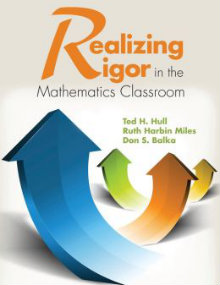A Detailed Guide to Rigor in Math Class
Realizing Rigor in the Mathematics Classroom
By Ted H. Hull, Ruth Harbin Miles, and Don S. Balka
(Corwin, 2014 – Learn more)
Reviewed by Dina Murphy
Math teachers throughout the United States are facing the challenge and requirement of increasing rigor in their classrooms. At first glance, this seems to imply simply increasing the difficulty: Merriam Webster, after all, defines rigor as “harsh inflexibility,” and “the quality of being unyielding.” Webster Online Dictionary’s entry includes a definition that reads “exactness without allowance, deviation, or indulgence.”
These definitions would seem to be putting teachers between a rock and a hard place, one way or another. Realizing Rigor in the Mathematics Classroom will help teachers, curriculum coaches, and school leaders avoid obstacles, pitfalls and traps on their way to achieving rigor and elevating learning for their students.
While dictionaries define the term as rigid, inflexible, or unyielding, educators frequently apply rigor or rigorous to assignments that encourage students to think critically, creatively, and more flexibly.– The Glossary of Education Reform

We are all, in education, being asked to make our instruction more “rigorous.” It behooves us, therefore, to understand what it means to provide this rigorous education to our students.
Inductive understanding
Realizing Rigor in the Mathematics Classroom achieves this understanding in an inductive manner, which is ultimately very effective. The authors use example problems — traditional, and reworked — to illustrate the difference between less and greater rigor in applied instruction.
The nuance of this enigmatic requirement, as the authors take pains to make clear, is that the learning behaviors tell the level of rigor. An active classroom, engaged students, teacher as facilitator rather than lecturer… these are the signposts of rigorous instruction.
Because rigor is an elusive aspect, and because it is nothing so simple as new content material or a classroom checklist, this book takes its time in building up to a clear understanding of the concept. The authors themselves point out that “There is no perfect definition of rigor.” (p. 19) Given the required outcomes, they achieve two definitions–
one for content:
“Mathematical rigor is the depth of interconnecting concepts and the breadth of supporting skills students are expected to know and understand.” (p. 22)
and one for instruction:
“Mathematical rigor is the effective, ongoing interaction between teacher instruction and student reasoning and thinking about concepts, skills, and challenging tasks that results in a conscious, connected, and transferable body of valuable knowledge for every student.” (p. 22)
The authors move forward from there, illustrating what is meant. Along the way, the reader benefits from example problems and descriptions of implementing them, illustrative case studies, guides for assessing levels of rigor achieved, and a consistent reassurance that change is not something that will be achieved overnight (or over the summer, as the case may be). To achieve rigor, teachers, coaches and leaders must all engage in a constant effort to put learning in the minds and hands of their students.
Obstacles and ways to overcome them
Part II of the book addresses obstacles to realizing rigor, while Part III explores solutions. An important understanding of this book is that many of the traditional approaches and relationships within schools are in themselves obstacles to achieving rigor.
Formative assessment, rather than summative assessment, will do more to address problems for both individual students and entire classes, and teachers need to work toward using such cues to adapt instruction on an ongoing basis. This holds true for teachers as well, however, which is a distinctive point this book makes.
An interactive assessment program for teachers and leaders is outlined and described, which seeks to be nonjudgmental and outcome based, and to be concerned more with the quality of learning the students are gaining, rather than with rating the teachers or catching them at fault. Indeed, the authors stress that both coaches and leaders need to spend more time in the classroom, interacting with students and supporting the teachers, rather than simply watching and rating.
This changes the relationship, the roles, the rules… and is just the sort of drastic change needed by and with teachers to create truly rigorous learning environments.
Input and Output goals for all roles
Part IV, the penultimate section of the book, very concisely describes parallel Input and Output goals for teachers, coaches, and leaders. This stresses — once again — the importance of all of these roles in achieving rigorous learning in the math classroom. The successful math department will recognize the need for, and work constantly to improve, the participation of all of these roles.
Realizing Rigor in the Mathematics Classroom will help earnest participants in any of those areas — principals, curriculum directors, department heads, instructional coaches and teachers — who are seeking to achieve rigor in their Common Core classroom. Indeed, even in non-Common Core states (I live and work in Texas, where our Texas Essential Knowledge and Skills [TEKS] Standards have just been revamped for mathematics), this book can be an invaluable tool. I fully intend to put quite a few of the practices and approaches I learned from reading this book into practice this year.
Dina Murphy teaches seventh grade Math at West Brazos Junior High in Brazoria, Texas. Despite having planned to teach Social Studies, she enjoys the challenges of helping students learn to share her love of math. Dina and her 7th grade math team partner are happily embracing technology in their classrooms, and have set themselves a high learning curve in order to offer their students a strong math curriculum that also gives them a good base in 21st century communication and work technology.



































